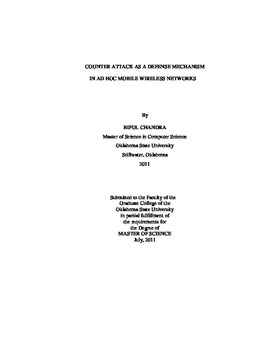| dc.contributor.advisor | Thomas, Johnson P. | |
| dc.contributor.author | Chandra, Bipul | |
| dc.date.accessioned | 2014-04-15T18:30:56Z | |
| dc.date.available | 2014-04-15T18:30:56Z | |
| dc.date.issued | 2011-07-01 | |
| dc.identifier.uri | https://hdl.handle.net/11244/8131 | |
| dc.description.abstract | Ad-Hoc Mobile Wireless Network (MANETs) have emerged and evolved in many forms. MANETs are rapidly gaining popularity because they do not rely on a pre infrastructure and can be deployed spontaneously. However, compared to wired networks, MANETs are more vulnerable to security attacks due to their unique features, such as stringent power consumption, error prone communication media and highly dynamic network topology. Most of the work done for improving security are focused on defensive mechanism like firewalls, gateways etc. Little research has been done on more offensive mechanisms to provide security. We propose three counter attack models, namely, Round Robin attack, Self-Whisper and flooding. The goal of all these attacks is to use up the intruder's critical resources like energy, communications bandwidth and force the intruder to eventually enter into DoS status. Simulation results shows that proposed counter attack models are an effective tool to counterattack. Simulation shows that a single model may not perform well in all situations. The choice of counter attack model is highly governed by the objective of counterattack. The Self-Whisper attack is the best if the objective is to have minimum energy consumption rate and minimum packet drop rate for agent nodes. On the other hand, if the protocol used is UDP, and the objective is to consume maximum amount of intruder energy, self- whisper performs better but if the objective is to have maximum packet drop rate at the intruder in the minimum time period, Round Robin is perhaps a best choice. Simulation shows that once counter attack begins, any traffic that is through intruder is disrupted. This disruption causes the ordinary nodes that have been tricked by the intruder advertizing false route information, to seek an alternate path to the destination. Hence, counter attack helps in improving security of the network as a whole. | |
| dc.format | application/pdf | |
| dc.language | en_US | |
| dc.publisher | Oklahoma State University | |
| dc.rights | Copyright is held by the author who has granted the Oklahoma State University Library the non-exclusive right to share this material in its institutional repository. Contact Digital Library Services at lib-dls@okstate.edu or 405-744-9161 for the permission policy on the use, reproduction or distribution of this material. | |
| dc.title | Counter Attack as a Defense Mechanism in Ad Hoc Mobile Wireless Networks | |
| dc.type | text | |
| dc.contributor.committeeMember | Kak, Subhash C. | |
| dc.contributor.committeeMember | Toulouse, Michel | |
| osu.filename | CHANDRA_okstate_0664M_11543.pdf | |
| osu.college | Arts and Sciences | |
| osu.accesstype | Open Access | |
| dc.description.department | Computer Science Department | |
| dc.type.genre | Thesis | |
| dc.subject.keywords | adhoc network | |
